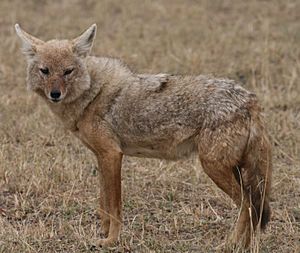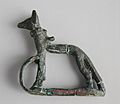African golden wolf facts for kids
Quick facts for kids African golden wolfTemporal range: Middle Pleistocene – Recent 0.6-0 Ma
|
|
|---|---|
 |
|
| Canis anthus bea in Ngorongoro Crater, Tanzania | |
| Conservation status | |
| Scientific classification | |
| Genus: |
Canis
|
| Species: |
anthus
|
| Subspecies | |
|
|
 |
|
The African golden wolf (Canis anthus) is a wild dog found in North Africa and the Horn of Africa. You can find them in many countries like Senegal, Nigeria, Chad, Morocco, Algeria, Tunisia, Libya, Kenya, Egypt, and Tanzania. This animal is not considered endangered; it's a "Least Concern" species, meaning there are plenty of them around.
These wolves can live in high places, even up to 1,800 meters (5,900 feet) in the Atlas Mountains. They are mostly predators, meaning they hunt other animals for food. Their diet includes small creatures like insects and mammals such as young gazelles. They also eat dead animals, leftover human food, and fruit. African golden wolves are quite territorial and don't like other wolves entering their space. Young wolves often stay with their family to help raise their parents' younger pups.
Contents
What Does an African Golden Wolf Look Like?
The African golden wolf has a long snout and big ears. Its tail is short, usually about 20 centimeters (8 inches) long. The color of their fur changes depending on the season and where they live.
Fur Color and Features
Their fur is usually yellowish to silvery-grey. Their legs often have a reddish tint. The throat, belly, and face are typically white. Their eyes are a beautiful amber color.
What Do African Golden Wolves Eat?
African golden wolves are not picky eaters! Their diet changes depending on where they live.
Food in West Africa
In West Africa, these wolves mainly hunt small prey. This includes:
- Hares
- Rats
- Ground squirrels and cane rats
- Lizards and snakes
- Birds that nest on the ground, like francolins and bustards
They also eat a lot of insects, such as dung beetles, larvae, termites, and grasshoppers. Sometimes, they will hunt larger young animals like gazelles, duikers, and warthogs.
Food in East Africa
In East Africa, their diet is similar. They eat insects and fruit. They also hunt rodents, lizards, snakes, birds, hares, and Thomson's gazelles.
Images for kids
-
Various C. lupaster phenotypes, ranging from gracile jackal-like morphs to more robust wolf-like ones.
-
Comparative illustration of C. aureus (top) and C. lupaster (bottom).
-
A Serengeti wolf (C. l. bea) navigating through a herd of blue wildebeest in the Ngorongoro National Park, Tanzania
-
Serengeti wolf (C. l. bea) eating an agama










